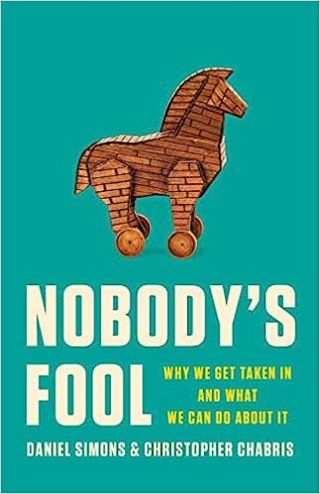Attention
Is Getting Through Life Increasingly About Not Getting Scammed?
The new book "Nobody’s Fool" can teach us how to not get scammed.
Updated July 18, 2023 Reviewed by Michelle Quirk
Every weekday, I drive my kids to and from school or summer camp, and we listen to the radio. My kids have memorized the phone number for QC Kinetics, have told me multiple times to download the free Upside App to get money back on gas, and often sing the Eureka Pizza jingle when they sense an opportunity to annoy me. I have not yet called the number or downloaded the app, but I have tried the pizza.
Given the daily onslaught of advertisements on the radio, emails asking me to submit articles to questionable journals, and other “opportunities” that present themselves, navigating life seems like a giant series of cognitive tasks—almost like a test—of trying not to get scammed. Luckily, a new book is now out titled Nobody’s Fool: Why We Get Taken In and What We Can Do About It by professors Daniel Simons and Christopher Chabris. What follows is a Q&A with the authors.
1. Getting through life feels like an onslaught of trying not to get scammed. How can your book help?
Simons and Chabris: We think your instinct is right: There are many signs that fraud is on the rise, it seems like there are new cons and frauds emerging all the time, and generative AI tools (ChatGPT, DALL-E, et al.) could accelerate the trend.
In Nobody’s Fool we approached the world of fraud and deception as cognitive psychologists. We studied scams from sports, art, finance, politics, science, medicine, and many other fields from the point of view of the victims, rather than the perpetrators, and identified several key patterns they have in common. The tactics of con artists may evolve over time and incorporate new technologies, but the thinking processes they exploit will likely stay the same. Our book provides a framework for understanding what makes us vulnerable and gives corresponding advice for how to be more vigilant—without becoming too mistrusting to have normal relationships!
One of the key cognitive habits we explain is how much we rely on focus when making decisions. Focusing on just the information we have readily available saves time and energy, and doing so usually works just fine. But scammers intuitively know we do this, and they have developed techniques to hold our attention on what they want us to see, distracting us from clues that would reveal their tricks. Theranos, the high-tech blood-testing firm led by Elizabeth Holmes and Sunny Balwani, developed elaborate protocols for demonstrating its devices to visiting investors that led them to believe one thing (that Theranos’s innovative, miniaturized, lab-in-a-box machines were running dozens of assays) when another was true (the visitors’ blood samples were spirited away to conventional labs and tested there).
We also discuss hooks or features of the information that scammers highlight and use to draw us in. For example, a good con artist knows that we are comforted by and place trust in what is familiar—or at least what feels familiar. Familiarity disarms our skepticism and makes us less likely to dig deeper. For example, the Malaysian businessman Jho Low, who famously partied with Leonardo di Caprio and financed “The Wolf of Wall Street,” allegedly laundered stolen assets by transferring money among various shell companies with names similar to those of established companies; he gave his “Blackstone Asia Real Estate Partners” a name similar to that of Blackstone Inc., the New York financial colossus, so that it would seem familiar to bankers and make them less likely to question sending it large wire transfers.
Throughout the book, we tell stories about people like Low, Holmes, Madoff, and many lesser-known individuals (have you heard of Frank Artiles, John von Neumann—the chess player, not the mathematician—or Glafira Rosales?), to help readers learn to spot the signs of deception before they get sucked in.
One reason we’re all vulnerable is that we tend to assume that only “gullible people” can be victimized. But many of the examples we describe show how highly accomplished and intelligent people have been scammed out of their fortunes and reputations—just consider some of the wealthy victims of Bernard Madoff’s Ponzi scheme, or the leading scientists who were tricked by their colleagues into publishing and believing fabricated findings. We hope that by learning about the cognitive mechanisms underlying many examples of deception, readers will be better able to spot when they’re at risk.

2. What have you learned from chess about being nobody’s fool?
Simons and Chabris: Like any competitive field, the game of chess has its share of cheaters and cheating scandals. Most famously, the world champion, Magnus Carlsen, quit a tournament last year because he believed one of his grandmaster opponents, 19-year-old Hans Niemann, had cheated against him. In online chess, hundreds of players are banned from platforms like chess.com every month for using computer assistance during games. One thing we’ve learned from experiencing chess cheating ourselves is that the signs of cheating aren’t as easy to spot as some people think. If your opponent makes some surprisingly good moves, they might be cheating, but they are more likely just having a good day—or you are making it easy for them by playing badly yourself. But if they are consistently making the best move, and consistently using the same amount of time on every move, and their rating has consistently gone up over the last days, weeks, or months, then something is probably amiss.
Real human performance is much more variable than computer-generated performance, just as real stock market returns have many more up-and-down swings than Bernie Madoff’s fake hedge fund did. We also learned the concept of a “blunder check”—a good chess player pauses before moving a piece to make sure they aren’t overlooking checkmate. We can apply that principle to any domain: Before making a big decision, take time to make sure you aren’t overlooking anything obvious. And while you can’t (legally) phone a friend during a chess game, you can always get a friend or advisor to take a second look at what you’re about to do.
3. Why should we ignore book blurbs?
Simons and Chabris: First of all, you should pay attention to all the very positive blurbs about Nobody’s Fool. But once you’ve bought our book, you can think about whether endorsements or testimonials, of which the blurbs on the back of books are one example, really provide useful information. Some blurbers seem to show up on dozens of book jackets per year—do they really read all those books? How do we know ChatGPT isn’t writing some of these blurbs for people too busy to do it themselves? How do we know how many blurbers declined to endorse a book? The same questions apply to any situation where you’re being shown a highly curated, tiny sliver of the relevant evidence, and the people showing it to you have a vested interest in what you do with that evidence. Anecdotes make us focus, and familiar names make us trust, so just keep in mind that you should look for more objective, independent evaluations before relying on them.
References
Simons, D., & Chabris, C. (2023). Nobody's Fool: Why We Get Taken In and What We Can Do Bbout It. Basic Books.




